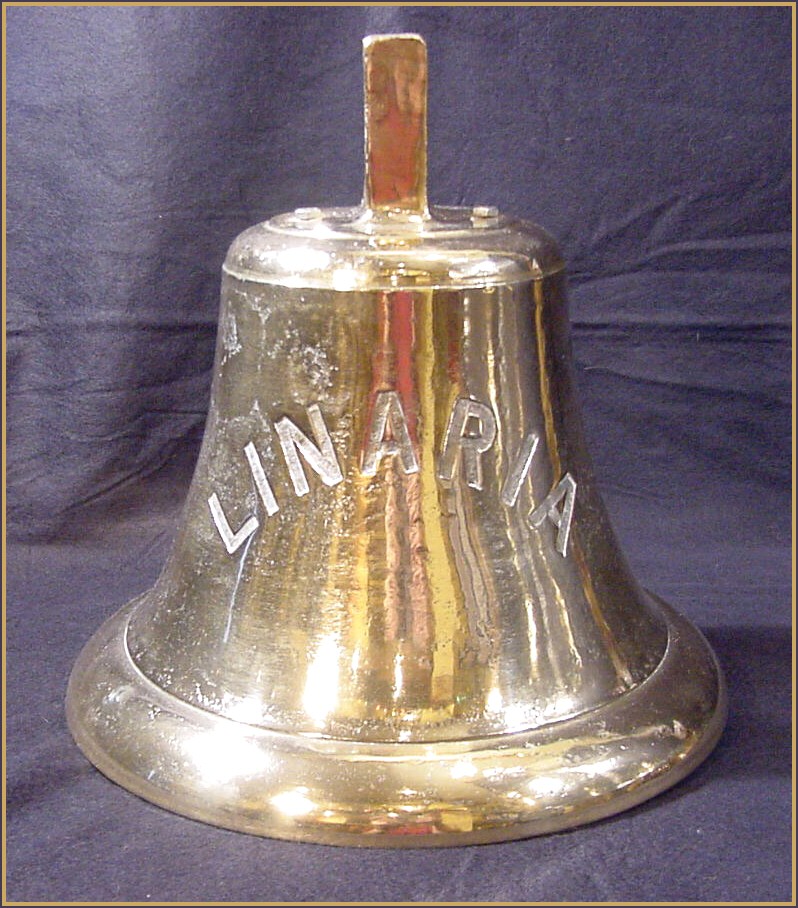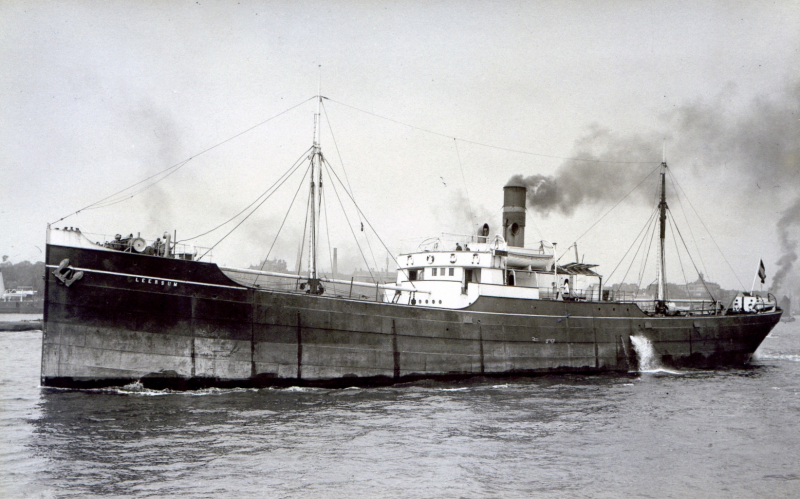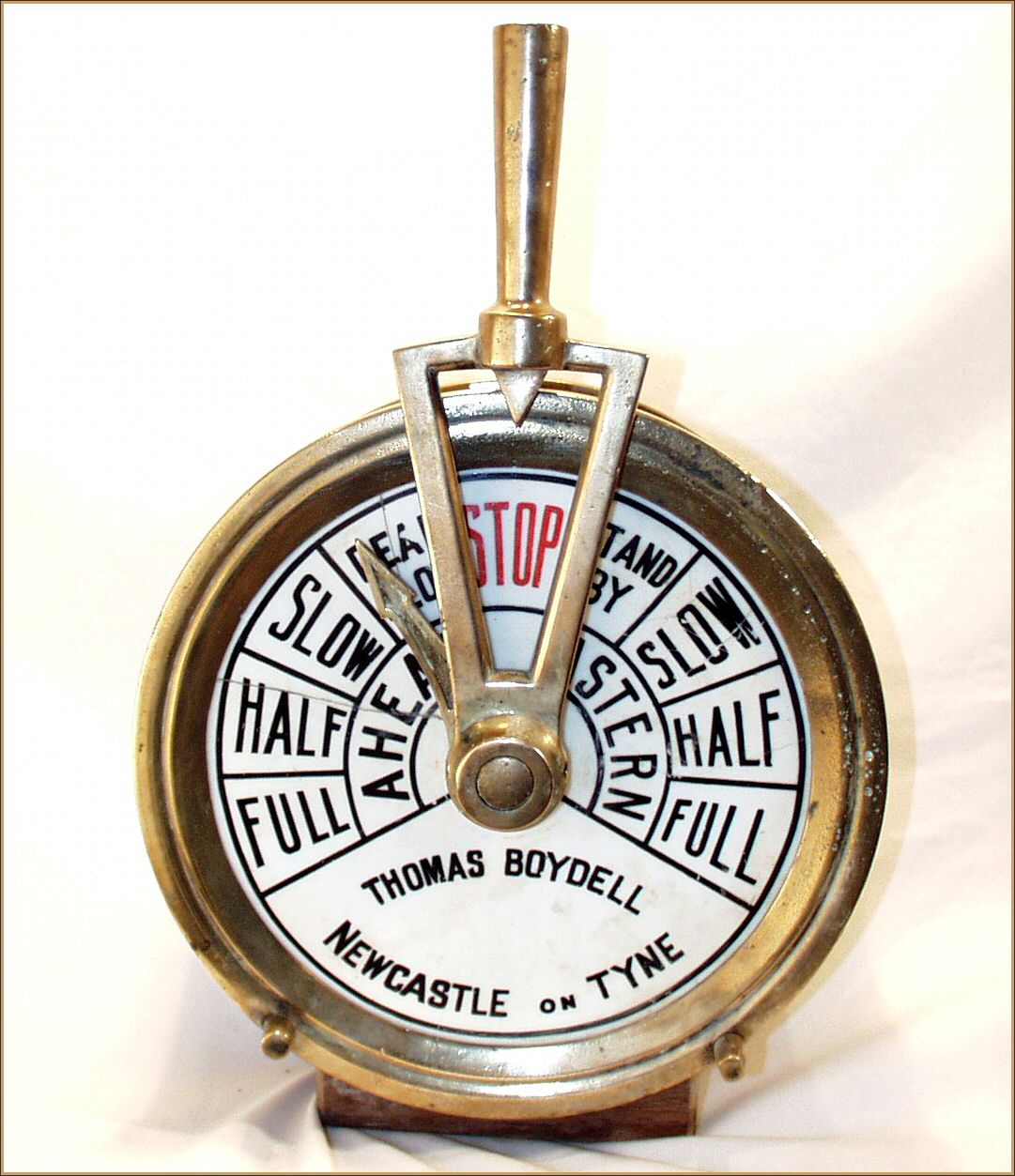26 December 1914 - Gelnmorven, Linaria, Leersum
The Glenmorven sailed from the Tyne for Leghorn (Livorno), Italy, with a cargo 3,620 tons of coal. She disappeared and is thought to have struck one of the Kolberg’s mines off Scarborough.
The SS Linaria, 26 December 1914
The British collier Linaria was in ballast and en route from London to the Tyne when at 16.45 she struck a mine. The explosion was thought to have blown the bottom out of the ship. However, the engine room was undamaged and so the captain planned to run the ship aground. However, the ship began to settle so quickly that he instead ordered the ship to be abandoned. The Linaria sank by the head two and half miles NNE of Filey. The crew of twenty-eight were saved by the Swedish ship SS Victoria who landed the crew at Sunderland the following day.
The ship’s bell was recovered by Barry Martin of Filey SAA during the early 1990's from the wreck known locally as 'Caravan' due to the transits using a caravan park along the local cliffs.

Leersum, 26 December 1914
The Amsterdam registered steamer Leersum was en route from Rotterdam to Newcastle with a general cargo, her captain, G. Stekelenburg, saw the explosion that sank the Linaria and sent the starboard lifeboat, manned by first mate J.G. Lagerweij and four sailors, to investigate. As they approached the Linaria there was another explosion and the stricken ship sank rapidly. As no survivors could be seen, the Leersum sounded its whistle as a signal for the lifeboat to return. When they were about halfway back to the ship, the Leersum struck a mine under her forecastle. The crew manned the remaining lifeboat as the ship’s stern was quickly out of the water.
Two people died, one was a Dutch fireman, J. Kraaijo, who it was thought was killed by flying debris down below. The other was H. de Cock, aged only sixteen years old, it was reported that his parents had been killed when the Germans invaded Belgium, which caused him to flee the country. He had made his way to Rotterdam where he found work as a fireman on the Leersum. It was his first voyage. When the ship struck the mine he refused to get into a lifeboat and stood watching, reportedly frozen with fear, refusing all pleas to lower himself into the boat. The crew threw a rope to him, but he remained motionless, further shouts for him to jump into the sea were ignored. The crew remained close to the sinking ship as long as they dare, but finally fears of being pulled down by the suction of the floundering ship forced them to row away. After three hours in the lifeboat they were rescued by a trawler and landed at Scarborough. The Scarborough lifeboat, under the Second Coxswain J. Crawford, was called out and took the Leersum’s lifeboats in tow.
The survivors were placed under the care of the Shipwrecked Mariners’ Society. The men were lodged at Mrs. Christian’s, 21 Sandside, where dozens of other sailors were taken care of after becoming victims of the mines. The men were provided with ‘shirts, vests, stockings and pants’. It was also reported that Captain Stekelenburg and the other survivors of the Leersum ‘recuperated' in the Jubilee Inn. They returned to home via Hull, Tilbury and finally abroad the SS Batavier III to Rotterdam on New Year’s Eve. In March 1915 the captain of the Leersum, G. Stekelenburg, revisited Scarborough to offer his thanks to the Shipwrecked Mariners' Society, Scarborough agent, Mr W.H. Ellis. He donated the life boats in which his crew escaped the loss of the Leersum to the society, they were sold for £10, which was then donated to the Shipwrecked Mariners' Society funds .
Despite the continuing losses, the progress made by the minesweepers mean that the Admiralty announced that shipping could recommence north of the Humber. A swept channel was passable initially in daylight only. The disruption to shipping had been immense. At Hull alone 120 trawlers were reported to be laying idle and 150 other vessels were at anchor in the Humber.
The wreck of the Leersum has been rediscovered by divers and several items, including gin bottles marked Amsterdam, have been recovered.
Crewmen killed on Leersum
J. Kraaijo, fireman, Holland
H. de Cock, fireman, aged 16, Belgium


Despite the continuing losses, the progress made by the minesweepers mean that the Admiralty announced that shipping could recommence north of the Humber. At Hull alone 120 trawlers were reported to be laying idle and 150 other vessels were at anchor in the Humber.
The Lost Ship: Glenmorven
On the morning of Boxing Day 1914 the collier the Glenmorven sailed from the Tyne for Leghorn (Livorno), Italy, with a cargo 3,620 tons of coal. Italy was a major importer of British coal, the country had industrialised relatively late for a developed European economy, but had almost no coal reserves of her own, hence the reliance on British coal. Of course, from April 1915 Italy was also an ally of Britain and France in prosecuting the Great War and was particularly important in countering the threat from the Austro-Hungarian Empire, with whom Italy shared a land border. Somewhere on her journey along the east coast the Glenmorven was lost, she simply disappeared without trace, it was assumed that she had become a victim of the Kolberg’s minefield off Scarborough. That assumption was arrived at due to the fact that the Glenmorven would have, passed through the minefield when it was at its most dangerous, and that the ship had not passed though the Strait of Dover, where shipping was carefully noted. The main source for shipwrecks online, the fabulous Wrecksite.eu listed her as a ‘highly probable’ victim of the Kolberg minefield. However, whilst researching the ship for the coming project I came across the evidence offered to the Board of Trade enquiry into the loss of the Glenmorven, by the captain of the streamer Joseph Davis. He stated that the Joseph Davis left the Tyne at the same time as the Glenmorven and they remained in close proximity until the Joseph Davis stopped to make repairs to her engines at the Inner Dowsing, off the Lincolnshire coast on 27 December. He watched the Glenmorven depart on the usual shipping course towards Cromer. He was probably the last person to see the ship again. For the twenty-four strong crew of the Glenmorven the sailing, although undertaken with Britain at war, would have been relatively mundane. The ship had been built by Palmer’s Shipbuilding & Iron Co. Ltd. at Jarrow. She was launched on 23 December 1882. The 2,812 ton collier was owned by several Leith-based shipping companies. For three decades she had conveyed coal from the River Tyne to various ports around Britain and Europe. The Glenmorven would have been a familiar sight to those who worked and lived alongside the river. Over half the crew were either born or lived on the banks of the Tyne. But even among their number were sailors who were born overseas. The ship’s second mate David Macfarlane was born at Quebec and the cook John Robertson at Ceylon. It is possible that their birthplaces were linked to military service of their fathers. Two other sailors living on Tyneside were born in Scandinavia; Able Seaman J. Thompson (possibly an Anglicised name) was born in Christiania (Oslo) and steward Julius Wedderkopp in Copenhagen. The latter was married to an Englishwomen, Winifred Wedderkopp (nee Nicholson), of 39, Linskill St., North Shields. Five of the crew were classed as ‘Indian’. It is estimated that during the Great War around 30% of sailors in the British Mercantile Marine were not British and 17.5% were ‘Lascars’ (seamen often of Asian and Arab origin); in total nearly 1 in 6, or 51,000 men. These 51,000 sailors were, among others, Yemeni, Indian, Malay, Somali, West African, Egyptian, Chinese, Burmese, Siamese, Indonesian and West Indian. They were often recruited from colonial ports, such as Aden, Lagos, Kingston, Cape Town, Calcutta, Bombay, Hong Kong and Singapore. A recurring theme in the losses of the ships lost in the Scarborough minefield is the high number of ‘Indian’ sailors serving in engine rooms. The nature of the work in confined spaces, deep within the ship, was dangerous enough in peacetime. But given the nature of warfare in the North Sea, where the vast majority of merchant shipping losses were the result of mines and torpedoes, those working in the engine rooms were especially vulnerable. Even if the denotation wasn’t directly on the engine room, the danger of fractured high-pressure steam pipes and red-hot boilers are obvious. Additionally, in the case of a rapid sinking, the engine room crew could easily become entombed below decks. As the crew of the Glenmorven have no known grave, they are commemorated on a number of memorials around the world. In death the crews are remembered, not as one, but on two separate memorials; in London and Mumbai (Bombay). The separation of the ships crews was decided by the Imperial War Graves Commission in the 1920s when the memorialisation was being planned. Thus, whilst the British and European sailors who died on the Glenmorven are commemorated on the Tower Hill Memorial to the Merchant Navy and Fishing Fleets, the five Indian members of the crew are listed thousands of miles from the waters of the North Sea on the Bombay 1914-1918 Memorial. The latter commemorates more than 2,000 ‘Indian’ sailors who died in the First World War and have no grave. The sailors listed on the memorial are a mix of Indian, Adenese and East African. This article is planned as the first of a series in the build up to the official unveiling of the project researching the ships lost to the Scarborough minefield of 1914-15. It is a highly-collaborative project, involving many differing individuals and organisations. It is also a very open project which welcomes input, suggestions and comments. In essence goal of this project is to give the men lost off our shore their names and reunite them once more. Remember Scarborough they said. Scarborough will remember them. For further reading on the global nature of the Great War in the North Sea, Antony Firth’s The World’s War on the East Coast is highly recommended. Crewmen lost on Glenmorven: ALI BIN ALI, Fireman & Trimmer, Indian Merchant Service. Memorial: Bombay 1914-1918 Memorial, Mumbai ALI SALEH, Fireman & Trimmer, Indian Merchant Service. Memorial: Bombay 1914-1918 Memorial, Mumbai BALCOMB, ALFRED GEORGE (18), Apprentice, Mercantile Marine, Son of Alfred and Clara Balcomb, of Brankstone, Beacon Rd., Broadstairs, Kent. Born at Strood, Kent. Memorial: Tower Hill Memorial BOWER, WILLIAM (17), Apprentice, Mercantile Marine, Son of Alexander Bower, and Mary Jane Bower, of 51, Coburg St., North Shields. Born at South Shields. Memorial: Tower Hill Memorial HAMILTON, WILLIAM FRANCIS (34), Master, Mercantile Marine, Son of the late William and Mary Hamilton; husband of Mercy Catherine Hamilton, of 4, New St., Paignton, Devon. Memorial: Tower Hill Memorial HASAN GHULAME, Fireman & Trimmer, Indian Merchant Service. Memorial: Bombay 1914-1918 Memorial, Mumbai HEDWORTH, ROBERT HUNTLEY (27), First Mate, Mercantile Marine, Husband of Isabella Hedworth (nee Ramsey), of 14, Blunen Terrace, South Shields. Born at South Shields. Memorial: Tower Hill Memorial HERCUELSON, J (47), Able Seaman, Mercantile Marine, Born at Lerwick. Memorial: Tower Hill Memorial HUNTRESS, THOMAS JAMESON (30), Chief Engineer Mercantile Marine, Son of Eliza Huntress and the late John Huntress; husband of Mary Elizabeth Huntress (nee Slater), of 10, Sandwich Rd., South Shields. Born at South Shields. Memorial: Tower Hill Memorial KERR, MEYNELL (16), Mess Room Steward, Mercantile Marine, Son of Thomas Newman Kerr and Sarah Kerr, of 183, South Eldon St., South Shields. Memorial: Tower Hill Memorial MACFARLANE, DAVID (55), Second Mate, Mercantile Marine, Son of the late David Macfarlane; husband of Mary Sarah Macfarlane (nee Moffatt), of 19, St. Thomas St., Newcastle-on-Tyne. Born in Quebec. Memorial: Tower Hill Memorial MCKENDREY, ROBERT GEORGE (38), Donkeyman, Mercantile Marine, Son of the late William and Betsy McKendrey; husband of Elizabeth Taylor McKendrey (nee Ovington), of 1, Garwood St., South Shields. Born at Gateshead. Memorial: Tower Hill Memorial MCKENZIE, WILLIAM (51), Able Seaman, Mercantile Marine, Born at Edinburgh. Memorial: Tower Hill Memorial MCMULLEN, FRANK (62), Boatswain, Mercantile Marine, Son of the late William McMullen; husband of Sarah Elizabeth McMullen (nee Brown), of 19, Waldo St., North Shields. Born at Poole. Memorial: Tower Hill Memorial MILLER, WILLIAM (52), Third Engineer, Mercantile Marine, Son of the late William and Jane Miller; husband of Sarah Jane Miller (nee Ledger), of 79, West Holborn, South Shields. Born at Liverpool. Memorial: Tower Hill Memorial MUHAMMAD ALI, Fireman & Trimmer, Indian Merchant Service. Memorial: Bombay 1914-1918 Memorial, Mumbai PEACOCK, FRANCIS ROBERT (61), Carpenter, Mercantile Marine, Son of the late Richard George and Ellen B. Peacock; husband of Dorothy Peacock (nee Hull), of 89, Cleveland St., South Shields. Born at South Shields. Memorial: Tower Hill Memorial ROBERTSON, JOHN O. (46), Ship's Cook, Mercantile Marine, Born in Ceylon. Memorial: Tower Hill Memorial SALEH ALI, Fireman & Trimmer, Indian Merchant Service. Memorial: Bombay 1914-1918 Memorial, Mumbai THOMPSON, J (34), Able Seaman, Mercantile Marine, Born at Christiania, Norway. Memorial: Tower Hill Memorial THOMPSON, ALWIN (20), Apprentice, Mercantile Marine, Son of Alwin Car Thompson and Minnie Thompson, of 22, Olave St., Anlaby Rd., Hull. Born at Hull. Memorial: Tower Hill Memorial THORP, JOHN (51), Second Engineer, Mercantile Marine, Son of the late Joseph and Hannah Thorp; husband of Mary Thorp (nee Wilson), of 34, Ashley Rd., South Shields. Born at Leeds. Memorial: Tower Hill Memorial TODD, JOHN (17), Ordinary Seaman, Mercantile Marine, Born at Morpeth, Memorial: Tower Hill Memorial WEDDERKOPP, JULIUS CHARLES (44), Steward, Mercantile Marine, Son of the late John and Marie Wedderkopp; husband of Winifred Wedderkopp (nee Nicholson), of 39, Linskill St., North Shields. Born at Copenhagen. Memorial: Tower Hill Memorial Part of the aim of this project is to give those men their names and reunite them once more. Remember Scarborough they said. Scarborough will remember them.